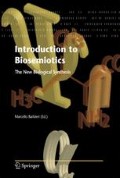Abstract
Because biology involves so many scalar levels and entrains so many aspects of Nature, the notion that it is essentially a direct consequence of genetic information is questioned. After discussing some general points about information and semiosis, the hegemony of genetics is rejected on the grounds that: basic cellular phenomena are generic for micellar systems, and that the overall pattern of development is generic for dissipative structures, and that supramolecular information emerges during development, and that closely similar forms and functions can emerge at the scale of organisms and above in distantly related genealogical lineages. During the course of the paper I suggest that various epigenetic systems may be semiotic entities
Access this chapter
Tax calculation will be finalised at checkout
Purchases are for personal use only
Preview
Unable to display preview. Download preview PDF.
Bibliography
Bateson, G., 1971. The cybernetics of “Self ”: A theory of alcoholism. Psychiatry 34: 1–18.
Bonner, J. T., 1952. Morphogenesis: An Essay on Development. Princeton: Princeton University Press.
Cairns-Smith, A.G., 1982. Genetic Takeover and the Mineral Origins of Life. Cambridge, UK: Cambridge University Press.
Calvano, S.E., et al, 2005. A network-based analysis of systemic inflammation in humans. Nature 437: 1032–1037.
Collier, J.D., 1998. Information increase in biological systems: how does adaptation fit? in G. Van de Vijver, S.N. Salthe and M. Delpos (eds.) Evolutionary Systems: Biological and Epistemological Perspectives on Selection and Self-organization. Dordecht: Kluwer Academic.
Conway Morris, S., 2004. Life’s Solution: Inevitable Humans in a Lonely Universe. Cambridge, UK: Cambridge University Press.
Corliss, J.B.,1988. Hydrothermal energy flow on planetary bodies and the creation of living systems. In Marx, G. (ed.), Bioastronomy – The Next Steps. Dordrecht: D. Reidel. pp. 195–200.
Dawkins, R. 1982. The Extended Phenotype. San Francisco: Freeman.
Ehrensvörd, C., 1960. Life: Origin and Development. Chicago: University of Chicago Press.
Eldredge, N., 1989. Macroevolutionary Dynamics: Species, Niches, And Adaptive Peaks. New York: McGraw-Hill.
Fox, S., 1988. The Emergence of Life: Darwinian Evolution From the Inside. New York: Basic Books.
Francis, S., Margulis, L. and E.S. Barghoorn, 1978. On the experimental silification of microorganisms II. On the time of appearance of eucaryotic organisms in the fossil record. Precambrian Research 6: 65–100.
Griffith, P.E. and D. Gray, 1994. Developmental systems and evolutionary explanation. Journal of Philosophy 91: 277–304.
Guimaraes, R. C., 2006. Stability in the genetic connections: The code and the nucleoprotein associations. Journal of Biosemiotics 2: in press.
Hoffmeyer, J., 1996. Signs of Meaning in the Universe. Bloomington, IN: Indiana University Press.
Lotka, A.J., 1922. Contribution to the energetics of evolution. Proceedings of the National Academy of Science. 8: 147–151.
Odum, H.T., 1971. Environment, Power and Society. New York: John Wiley and Sons.
Pattee, H.H., 1977. Dynamic and linguistic modes of complex systems. International Journal of General Systems. 3: 259–266.
Pattee, H.H., 1982. Cell psychology: an evolutionary approach to the symbol-matter problem. Cognition and Brain Theory 5: 325–341.
Polanyi, M., 1968. Life’s irreducible structure. Science 160: 1308–1312.
Rapoport, E.H., 1982. Areography: Geographical Strategies of Species. New York: Pergamon.
Rual, J.-F. et al, 2005. Towards a proteome-scale map of human protein-protein interaction network. Nature 437: 1173–1178.
Salthe, S.N., 1972. Evolutionary Biology. New York: Holt, Rinehart and Winston.
Salthe, S.N., 1985. Evolving Hierarchical Systems: Their Structure And Representation. New York: Columbia University Press.
Salthe, S.N., 1993. Development And Evolution: Complexity and Change in Biology. Cambridge, MA: MIT Press.
Salthe, S.N., 1998a. Naturalizing semiotics: an extended review of J. Hoffmeyer, 1996, Signs of Meaning in the Universe. Semiotica 120: 389–394.
Salthe, S.N., 1998b. Semiosis as development. In J. Albus and A. Meystel (eds.) Proceedings of the 1998 IEEE ISIC/CRA/ISAS, On Intelligent Systems. pp. 730–735. Gaithersberg: IEEE Press.
Salthe, S.N., 2001. Theoretical Biology as an anticipatory text: the relevance of Uexküll to current issues in evolutionary systems. Semiotica 134: 359–380.
Salthe, S.N., 2002a. Summary of the principles of hierarchy theory. General Systems Bulletin 31: 13–17.
Salthe, S.N., 2002b. An exercise in the natural philosophy of ecology. Ecological Modelling 158: 167–179.
Salthe, S.N., 2003a. Infodynamics, a developmental framework for ecology/economics. Conservation Ecology 7. www.consecol.org/vol7/iss3/art3.
Salthe, S.N., 2003b. Entropy: what does it really mean? General Systems Bulletin 32: 5–12.
Salthe, S.N., 2004a. The natural philosophy of ecology: developmental systems ecology. Ecological Complexity 2: 1–19.
Salthe, S.N., 2004b. The origin of new levels in dynamical hierarchies. Entropy 2004, 6[3]: 327–343. http://www.mdpi.net/entropy/list04.htm
Salthe, S.N., 2005a. Energy and semiotics: the Second Law and the origin of life. Cosmos and History 1: 128–145.
Salthe, S.N., 2005b. Semiotics in biology: inside neoDarwinism. Journal of Biosemiotics 2: in press.
Schneider, E.D. and Kay, J.J., 1994. Life as a manifestation of the Second Law of thermodynamics. Mathematical and Computer Modelling 19:25–48.
Spinks, C.W., 1983. Peirce’s demon abduction: or how to harm the truth out of a quark. American Journal of Semiotics 2: 195–209.
Stent, G., 1981. Strength and weakness of the genetic approach to the development of the nervous system. Annual Review of Neuroscience 4: 16–19.
Uexküll, J. von, 1926. Theoretical Biology. London: Harcourt, Brace.
Ulanowicz, R.E., 1997. Ecology, the Ascendent Perspective. New York: Columbia University Press.
Ulanowicz, R.E., 2004. New perspectives through brackish water ecology. Hydrobiologia 514: 3–12.
Van Valen, L., 1973. A new evolutionary law. Evolutionary Theory 1: 1–30.
Willey, A., 1911. Convergence in Evolution. New York: E.P. Dutton.
Author information
Authors and Affiliations
Editor information
Editors and Affiliations
Rights and permissions
Copyright information
© 2008 Springer Science+Business Media B.V.
About this chapter
Cite this chapter
Salthe, S.N. (2008). What Is The Scope Of Biosemiotics? Information In Living Systems. In: Barbieri, M. (eds) Introduction to Biosemiotics. Springer, Dordrecht. https://doi.org/10.1007/1-4020-4814-9_5
Download citation
DOI: https://doi.org/10.1007/1-4020-4814-9_5
Publisher Name: Springer, Dordrecht
Print ISBN: 978-1-4020-4813-5
Online ISBN: 978-1-4020-4814-2
eBook Packages: Biomedical and Life SciencesBiomedical and Life Sciences (R0)

